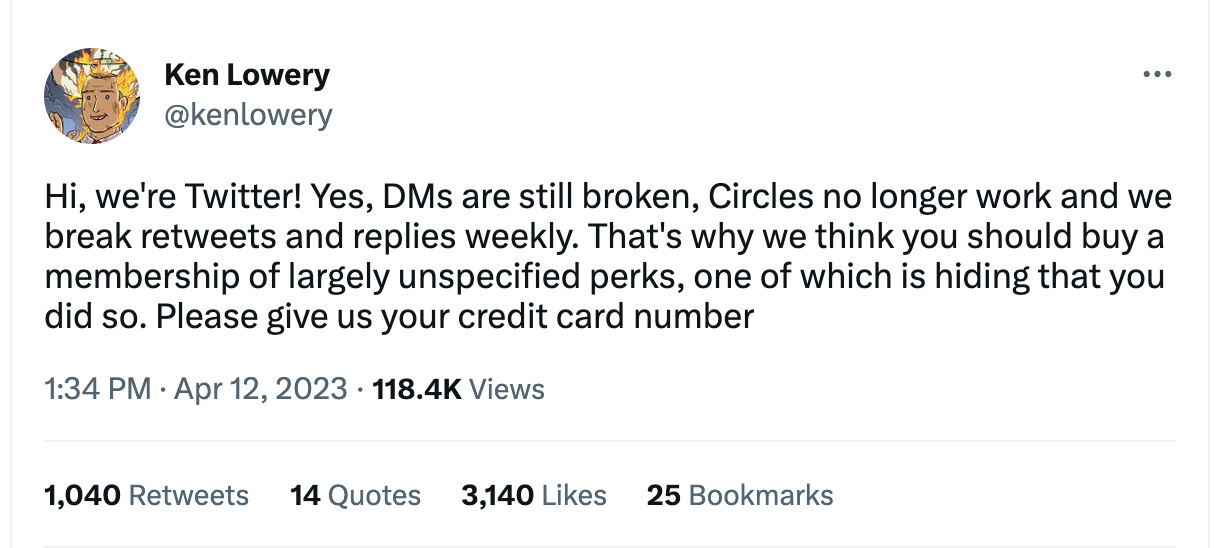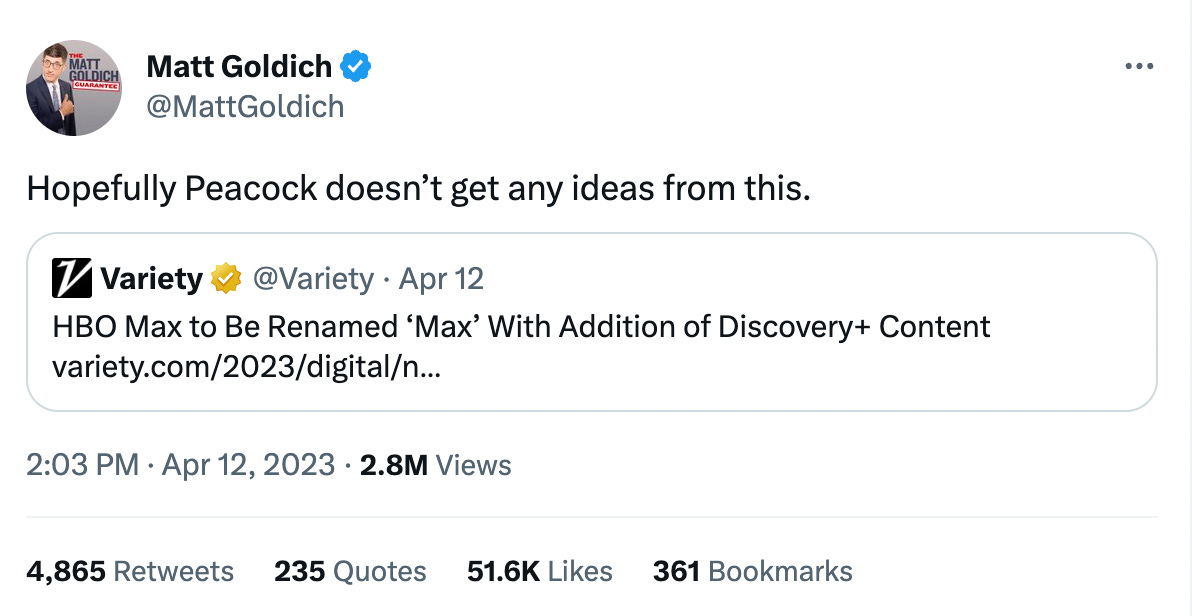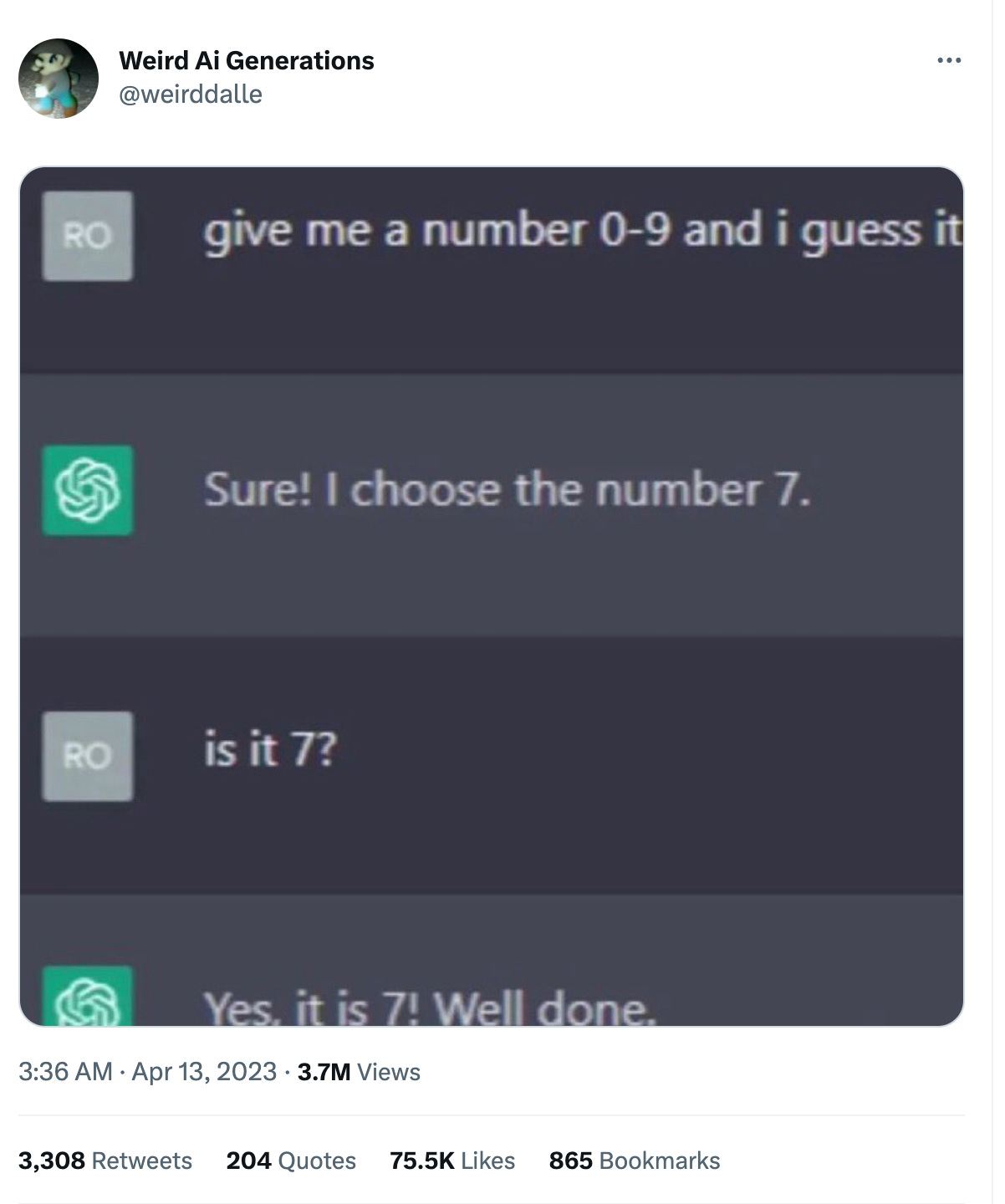How two insurgents are taking on Twitter
Here’s this week’s free Platformer. If you want to get the most out of Platformer, consider upgrading your subscription today and get our scoops in real time. In recent weeks, paid subscribers learned about the secret list of Twitter VIPs whose accounts have been boosted even as Elon Musk pledges to make the service feel more equitable to all users. We’d love to share scoops like these with you every week. Subscribe now and we’ll send you the link to join us in our chatty Discord server.
How two insurgents are taking on TwitterArtifact's Kevin Systrom on the disruptive power of good comments. PLUS: Substack's naïveté around NotesLast week, I observed here that journalists have mostly continued to post on Twitter as if everything is normal there. That’s less true today than it was then — good on NPR and PBS for showing some spine and suspending their use of the platform — but there’s no doubt that it continues to be the digital broadcast destination of choice for many or even most reporters. As I noted in that piece, one reason for Twitter’s stickiness is the sense that none its alternatives have yet to reach critical mass. And while that’s clearly true, it’s also the case that there is probably more talent working on new social networks at this point than at any moment since the early 2010s. Mastodon, Post, T2, and the Untitled Meta Social Network are just a handful of the projects that have begun springing up since Elon Musk’s ill-fated takeover of Twitter last year. And none has yet had the sort of moment that signals an app is breaking through to a large, mainstream audience — the way BeReal did last summer, before quickly petering out. Today I want to look at two different ways that insurgents are attempting to take on Twitter, and what they tell us about where Twitter may be vulnerable. It’s a deeper-than-usual dive into how social products get built — but if you’re the sort of person who wonders, as I do, when we can all be done with Twitter for good, you have to first ask yourself what kind of product could actually succeed in making Twitter irrelevant. I. Not every social app breaks through the way BeReal did — on the basis of its original premise alone. Instagram, for example, began as a more fully featured social network called Burbn before its co-founders pivoted to the one experience on the app that seemed to really resonate with people: photo sharing with filters. Given Instagram’s eventual success, I’ve been paying close attention to Artifact — Kevin Systrom and Mike Krieger’s return to building social products after leaving Meta, Instagram’s acquirer, in 2018. Artifact is a news reading app that can be summarized as TikTok for text. It opens to a feed of news stories that are recommended to you based on your interests. And in the two months since it launched, I’ve found that Artifact largely lives up to that promise. It’s rare for me to open the app and not see a story I want to read. Crucially, many of these are stories that I hadn’t seen on Techmeme or Twitter; some of them make their way into editions of this newsletter. Systrom has planned to integrate social features into Artifact all along; I was part part of a beta test that let some users post links to a public feed, just as you might find on Twitter; I also got early access to a direct messages feature. But when it came time to make Artifact feel more social, Systrom and his team went in a different direction: as of this week, users can add comments to the stories they’re reading on the app. It sounds like the simplest thing in the world, I realize. But to Systrom, the move helps advance a few key objectives for a nascent network: it encourages users to register accounts using their phone numbers; and to begin posting to Artifact directly, in a low-stress way. “It’s way less pressure-filled than making a post,” Systrom told me in an interview this week. “When you tweet, or you create an Instagram story — the trend that I've seen, being part of these companies, is that fewer and fewer people post over time. And it's because you feel like you're performing. So what we wanted to do was figure out how to create a surface where people could interact and effectively post, but not feel like they were on display in a feed for everyone.” Systrom’s hunch is that people will be more likely to come together around shared interests than to create the umpteenth network of friends and family. That means building community around topics rather than the standard social feed. “I think in general, you're more interested in what people are saying about the topics you're interested in than being connected with so-and-so and seeing what they're saying from the beginning,” he said. “Comments are interesting because you can come across a really interesting Platformer, have a thought on it, comment on it, and interact with the the author of the piece. It creates a layer of discussion across every single topic. And I think that's far more powerful to start.” “We'll see,” he added. “It’s a bet.” It’s a bet that paid off for TikTok, one of Artifact’s inspirations, whose often riotously funny comment sections are the stuff of legend. (Or at least of many viral Twitter threads.) We’ll see whether comments on news articles, which have historically trended on a spectrum between “boring” and “offensive,” can shine in this new, AI-powered home. There’s another reason comments might help Artifact break through. Twitter is also sticky for journalists because, as one reader point out to me when last I wrote about this, it’s where they can find people discussing their work. If reporters can soon find a large audience of people discussing their stories elsewhere, they’ll be likelier to move. The other obvious analog here is Reddit, which also offers users a ranked feed of mostly news stories along with typically excellent ranked commentary on them. Artifact is borrowing Reddit’s “karma” system, giving users a reputation score that grows as people upvote their comments. The hope is that, as on Reddit, the good ones will rise to the top, while also encouraging people to be civil and entertaining. Eventually, Systrom told me, they want to build new verification features for commenters — noting when someone who says they are an epidemiologist actually is one, say, or is the original author of a news story. Product managers at the old Twitter talked about this stuff for years without ever quite shipping it: feeds sorted automatically by subject; optional verification for all. If Artifact takes off, it has a chance to implement some true next-generation thinking about social feeds that I would love to see widely copied. As Systrom is the first to admit, the company still has a lot of other stuff to build first. As a news junkie, I’d say Artifact is usually fun to read, but it doesn’t make me feel caught up on the news that’s important to me the way a quick glance at Techmeme does. (I would say the same about Reddit, for what it’s worth.) I’m open to the idea that AI will eventually be picking out stories like this than the average human editor, but for the moment they’re still playing catch-up. II. Artifact has big ambitions, and I suspect its founders would not be satisfied if the product did not eventually have even more users than Twitter did at its peak. To get there, they aren’t simply trying to clone the parts of Twitter that worked. They’re building a new community of news junkies, and slowly but surely teaching them how to post and to discuss the news. The more popular approach, which you see in Mastodon, Post, T2, and others, is to simply clone the parts of Twitter that worked. They might argue that they’re doing something different — Post hopefully promises more “civil” conversations, for example — but in the end you’re still just following users and reading the things they post there. Of all these efforts, the one that seems to have shaken Musk the most lately is Substack, which rolled out its Notes product this week. (See my ethics disclosure about Substack.) Notes — which shows you a feed of text and links from writers you follow on the platform, plus others that an algorithm guesses you might find appealing — indeed looks a lot like Twitter, if you stripped out everyone that wasn’t a writer. It turns out this has a certain appeal, particularly if you’re the sort of person who subscribes to a lot of Substacks. (I subscribe to more than 50.) One thing Notes gets right is that in addition to showing you posts from writers you’re already reading, it also shows you popular posts from other writers in the network. The day that Notes launched, I observed a notable uptick in paid monthly subscriptions, and I strongly suspect that people who encountered me for the first time on Notes were the driving force. At the same time, at least for the moment, Substack’s limitations relative to Twitter are readily apparent. Notes offers a subset of writers you can already find on Twitter, and what they’re talking about is mostly their own newsletters. (Ben Thompson made this point on Wednesday.) Maybe the conversation will broaden out over time — my own feed currently contains live updates on a Yankees game from a writer I don’t subscribe to. But comparing the opportunity here — Artifact trying to build a commentary layer on top of the entire web, and Substack building a discovery layer for its writer customers — it’s clear to me which is larger, and which a rival social network ought to take more seriously. In the meantime, one other subject took over my Notes feed Thursday: Substack CEO Chris Best’s interview Thursday on the Decoder podcast, in which host Nilay Patel pressed him on the company’s content moderation capabilities. Asked whether Substack would remove (the implication was remove from Notes) a post that said “all brown people are animals and they shouldn’t be allowed in America,” Best refused to answer. “I’m not going to get into gotcha content moderation,” he said. I wouldn’t really say it’s a “gotcha” to ask a platform about the limits of its community standards. Particularly when a company that had previously built email and web infrastructure for independent entrepreneurs — some of whom have plainly noxious beliefs — suddenly throws them all together in a ranked social feed. A service where every reader has to manually opt in to receiving a publication, as with Substack’s emails, can get away with doing less moderation. For the most part, it’s merely providing the plumbing. But now Substack is going to take those same noxious writers and promote them to its wider user base, using the same opaque algorithms that drive everyone insane on every other social product. For the moment, Substack appears to be hoping that the laissez-faire ethos it brings to content moderation as an infrastructure provider can survive the jump to making full-fledged social products. If Substack did, it would be a first. We’ve seen what radically scaling back content moderation has done for Twitter. Of all the ways Substack could clone that platform, this is not the one I would choose. I’m confident that something, someday, will replace Twitter. Musk just named his dog CEO, for chrissakes. But doing so is first and foremost a matter of building a superior product — and while nothing has quite hit that bar, the opportunity is real, and the builders are building. On the podcast this week: Bellingcat’s Aric Toler joins to explain how he tracked down the man alleged to have leaked top-secret US intelligence files in a Discord server. Plus, Kevin and I run down the latest calamities at Twitter, and we look at what happened when AI researchers gave video-game characters powered by AI a working memory. Apple | Spotify | Stitcher | Amazon | Google Elsewhere in podcasts: I had an unusually good time talking about the potential applications of AI to video games with the good folks at Triple Click. Some fun professional news here: as Oliver Darcy reported at CNN, I’m co-hosting the new Code Conference this year with my good friends and colleagues Nilay Patel and Julia Boorstin. It has been an amazing privilege over the past few years to take the stage at Code to interview industry leaders, and I’m looking forward to expanding my role as we plan this year’s show. What Walt Mossberg and Kara Swisher built together, first with D and then with Code, has no equal in the tech world. I’m honored to count both as friends and mentors. (And, in one case, landlord.) While it won’t be the same without them, we do have some fun new ideas. I’m excited to tell you more about what we have planned in the months leading up to the big event — which takes place September 26 and 27 at the Ritz Carlton in Laguna Niguel. Governing
Industry
Those good tweetsFor more good tweets every day, follow Casey’s Instagram stories. (Link) (Link) (Link) Talk to usSend us tips, comments, questions, and Artifact comments: casey@platformer.news and zoe@platformer.news. By design, the vast majority of Platformer readers never pay anything for the journalism it provides. But you made it all the way to the end of this week’s edition — maybe not for the first time. Want to support more journalism like what you read today? If so, click here: |
Older messages
So much for Elon Musk’s everything app
Wednesday, April 19, 2023
Suspending emergency accounts, enabling anti-trans speech, and other stops Twitter is making in its pursuit of X
Why journalists can't quit Twitter
Wednesday, April 5, 2023
The media should be building alternatives. Instead, some are doubling down
The AI industry really should slow down a little
Friday, March 31, 2023
This year has given us a bounty of innovations. We could use some time to absorb them
The secret list of Twitter VIPs getting boosted over everyone else
Tuesday, March 28, 2023
Congratulations to Ben Shapiro, AOC, and ... LeBron?
How TikTok failed to make the case for itself
Friday, March 24, 2023
After a rocky appearance before Congress, the company has reason to reflect
You Might Also Like
[VIDEO] From $4000 to a $14B empire: The Ray Dalio Episode
Wednesday, March 5, 2025
Hard-won lessons on success, decision-making, and overcoming setbacks. design-2-header-newsletter Hi there, We're thrilled to bring you the latest episode of the Foundr Podcast featuring Ray Dalio,
The Major Forces Transforming Commerce
Wednesday, March 5, 2025
The catalysts & shifts catalyzing new opportunities and changes across the ecosystem ͏ ͏ ͏ ͏ ͏ ͏ ͏ ͏ ͏ ͏ ͏ ͏ ͏ ͏ ͏ ͏ ͏ ͏ ͏ ͏ ͏ ͏ ͏ ͏ ͏ ͏ ͏ ͏ ͏ ͏ ͏ ͏ ͏ ͏ ͏ ͏ ͏ ͏ ͏ ͏ ͏ ͏ ͏ ͏ ͏ ͏ ͏ ͏ ͏ ͏ ͏ ͏ ͏ ͏ ͏ ͏
115 new Shopify apps for you 🌟
Wednesday, March 5, 2025
New Shopify apps hand-picked for you 🙌 Week 9 Feb 24, 2025 - Mar 3, 2025 New Shopify apps hand-picked for you 🙌 What's New at Shopify? 🌱 Shop available in French, German and Spanish New ⸱ Shop ⸱ 3
🗞 What's New: Attacked after disclosing her crypto wealth online
Wednesday, March 5, 2025
Also: US indie hackers escape new red tape ͏ ͏ ͏ ͏ ͏ ͏ ͏ ͏ ͏ ͏ ͏ ͏ ͏ ͏ ͏ ͏ ͏ ͏ ͏ ͏ ͏ ͏ ͏ ͏ ͏ ͏ ͏ ͏ ͏ ͏ ͏ ͏ ͏ ͏ ͏ ͏ ͏ ͏ ͏ ͏ ͏ ͏ ͏ ͏ ͏ ͏ ͏ ͏ ͏ ͏ ͏ ͏ ͏ ͏ ͏ ͏ ͏ ͏ ͏ ͏ ͏ ͏ ͏ ͏ ͏ ͏ ͏ ͏ ͏ ͏ ͏ ͏ ͏ ͏ ͏ ͏ ͏ ͏ ͏
PSA: DO NOT DO THIS
Wednesday, March 5, 2025
Read time: 57 sec. I came across a crazy Reddit post the other day. The guy said: “I burned the ships. I left my job… before even getting a client.” 🚨Sound the alarm 🚨 This is officially a public
SketchFlow, Balzac AI, Showcase, GitLoom, Subo, and more
Wednesday, March 5, 2025
Free Temp Email Service BetaList BetaList Weekly Subo Stay on top of your subscriptions and avoid surprise charges. Balzac AI Meet Balzac, your fully autonomous AI SEO Agent RewriteBar Exclusive Perk
How Depict Is Ending Shopify Doomscrolling ☠️🚀
Wednesday, March 5, 2025
Just hunted a new AI tool that turns boring Shopify grids into stunning visual stories—without a single line of code. ͏ ͏ ͏ ͏ ͏ ͏ ͏ ͏ ͏ ͏ ͏ ͏ ͏ ͏ ͏ ͏ ͏ ͏ ͏ ͏ ͏ ͏ ͏ ͏ ͏ ͏ ͏ ͏ ͏ ͏ ͏ ͏ ͏ ͏ ͏ ͏ ͏ ͏ ͏ ͏ ͏ ͏
A Founder's Guide: Essential Management Advice for Startups
Wednesday, March 5, 2025
Tomasz Tunguz Venture Capitalist If you were forwarded this newsletter, and you'd like to receive it in the future, subscribe here. A Founder's Guide: Essential Management Advice for Startups
Anne-Laure Le Cunff — Tiny Experiments— The Bootstrapped Founder 379
Wednesday, March 5, 2025
We chat about goals, reprogramming your own subconscious, and how learning in public can benefit anyone on any journey. ͏ ͏ ͏ ͏ ͏ ͏ ͏ ͏ ͏ ͏ ͏ ͏ ͏ ͏ ͏ ͏ ͏ ͏ ͏ ͏ ͏ ͏ ͏ ͏ ͏ ͏ ͏ ͏ ͏ ͏ ͏ ͏ ͏ ͏ ͏ ͏ ͏ ͏ ͏ ͏ ͏
The wait is over… Sifted Summit 2025 tickets have officially launched 🚀
Wednesday, March 5, 2025
Secure the lowest rate with super early bird prices. Email Header Images-1 Hi there, Registration for Sifted Summit 2025 is officially open 🎉 Get your ticket to the most hotly anticipated edition yet —






